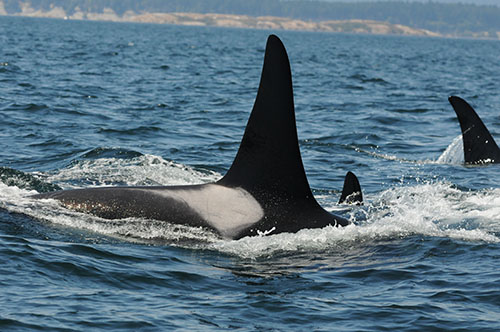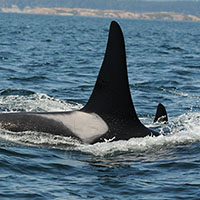— from Kenneth C. Balcomb, Senior Scientist of the Center for Whale Research —

L95-Photo by Dave Ellifrit
On 2 April 2016 we received photographs of a decomposing dead male killer whale found near Tahsis, on the west coast of Vancouver Island, Canada. The epidermis had deteriorated to the point that no pigmentation was evident to make a definitive photo-identification match to our Southern Resident Killer Whale (SRKW) catalogue, however two small puncture wound sites near the right trailing edge of the dorsal fin at the fin base led to our surmise that it had been satellite tagged and might be in our follow-up files for whales that had been tagged. It was not. The only whale that we knew of that had been tagged recently that was not in our files was L95, so we surmised that the dead whale was L95. A field necropsy was done 1 April 2016.
On 13 April 2016, the Department of Fisheries and Oceans Canada and the National Oceanic and Atmospheric Administration USA released an announcement that the Tahsis carcass was that of L95, a twenty year old SRKW that had been satellite tagged on 24 February 2016 offshore of La Push, WA. The tag functioned for three days in the same general area off the Washington coast and then contact was lost. Inclement weather precluded follow-up on the whale’s condition and no photographs were forwarded to the Center for Whale Research (CWR) for any follow-up on this whale in the Salish Sea. The cause of death for L95 has not yet been finally determined pending further analysis, but the tagging injury and death were considered coincidental.
There are two other satellite tagged whales (both Transient or Bigg’s whales) that have gone missing or have died subsequent to tagging (T14 and T99A), and maybe these are also coincidental losses. However, it is not coincidental that at least seven other satellite tagged whales are still carrying hardware embedded in their tissues from the attachment fixtures, and some of the wounds have festered with restructuring tissue around the attached hardware.
In my opinion, the tag attachment methodology was overly barbaric and defective from the get-go, and the entire tagging program should be rethought and evaluated for efficacy. The NOAA/NMFS tagging program is certainly injuring and disfiguring these Endangered icons of the Pacific Northwest, and it is my subjective opinion that it is adversely altering their behavior toward benign vessel interactions to approach them for photo-identification. Like any wildlife, they become gun-shy when the interactions with humans become aggressive and they are impacted with bullets, harpoons, or biopsy hardware, some of which seriously injures them. State of the art medical and veterinary procedures are designed to be minimally invasive on tissues to minimize tissue-healing problems, not maximize tissue damage for attachment duration and inappropriate package size.
I discussed these shortcomings with Dr.’s Mike Ford and Brad Hanson several years ago and was told the sat tagging program would proceed in spite of my concerns; and, I was instructed to simply document tag healing and report any issues to them, which I have done. I do not know if these problems have been reported up the chain of command to the NOAA/NMFS Permit Office, but the feedback I have been receiving is that the hardware issues of yesteryear have been “fixed”. Clearly, with L95 still retaining tag hardware in his wound site the hardware attachment issues have not been fixed. I suggest evaluating the cost efficiency and data already gathered from sighting reports, photo-id, and tagging to determine whether any additional studies of SRKW distribution are justified.
We are all awaiting the full necropsy reports for L95, the dead neonate SRKW found floating off Sooke BC, in March, and J32 found freshly dead near Comox, BC in December 2014.
**If you are reading theOrcasonian for free, thank your fellow islanders. If you would like to support theOrcasonian CLICK HERE to set your modestly-priced, voluntary subscription. Otherwise, no worries; we’re happy to share with you.**









Thank you for sharing this troubling news. I don’t expect this will be the last we hear about this issue. I imagine most of us would vote for less data in exchange for healthier Orca whales.
What can we do to help stop satellite tagging? These deaths are tragic and obviously caused by puncturing the whales. I mourn the death of yet another of our resident whales.
I am saddened by this information and sincerely hope NOAA will discontinue tagging until it can be proven that it is not related to the loss of this invaluable animal.